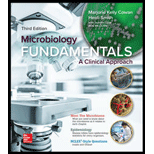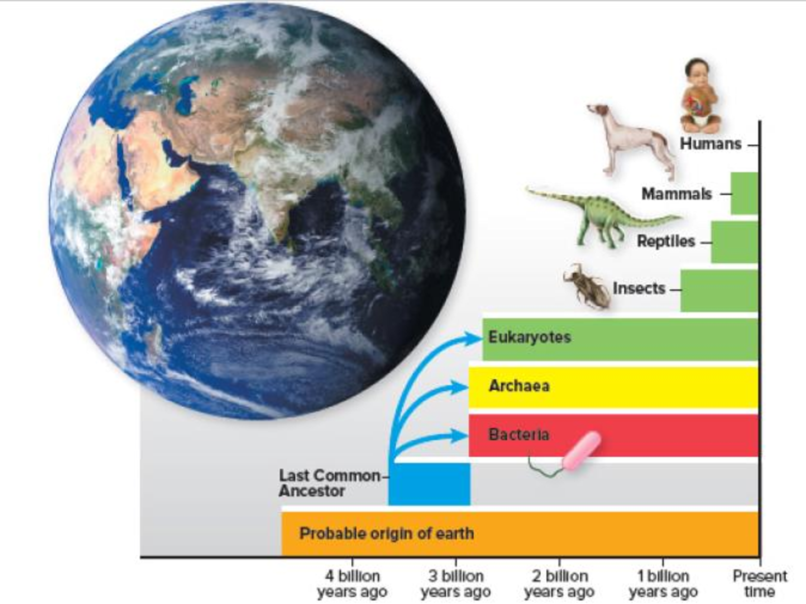
Microbiology Fundamentals: A Clinical Approach
3rd Edition
ISBN: 9781259709227
Author: Marjorie Kelly Cowan Professor, Heidi Smith
Publisher: McGraw-Hill Education
expand_more
expand_more
format_list_bulleted
Textbook Question
Chapter 1, Problem 1VC
Figure 1.2 Look at the red bat (the time that bacteria have been on earth) and at the time that humans appeared. Speculate on the probability that we will be able to completely eliminate all bacteria from our planet, and discuss whether or not this would even be beneficial action.

Expert Solution & Answer
Want to see the full answer?
Check out a sample textbook solution
Students have asked these similar questions
The table below shows the symptoms of some diseases that are caused by bacteria.
Disease
Symptoms
vomiting, abdominal pain, coughing,
muscular weakness, visual disturbance
botulism
inflammation of lungs, fever,
shortness of breath, fluid in lungs
pneumonia
typhoid fever
red rashes, high fever, intestinal bleeding
tetanus
uncontrolled contractions of voluntary muscles
Which two diseases listed in the table affect the digestive system? Be sure to support your reasoning with evidence from the table. Please write in complete sentences.
What is the best explanation for why a bacteriostatic treatment might be chosen over a bacteriocidal treatment? Bacteriostatic treatments will eliminate all bacteria while bacteriocidal treatments will only eliminate a portion of the bacteria. Bacteriostatic treatments typically have lower toxicity to the host when compared to bacteriocidal treatments. Bacteriostatic treatments will prevent all bacterial growth, while bacteriocidal treatments will permit some bacterial growth. Bacteriostatic treatments are typically more costly than bacteriocidal treatments.
Imagine you are an astronaut and you are the first person to walk on Mars. You make
the surprising discovery that there are "bacteria-like organisms" on Mars. Which of
the following do not need to be true for you to consider these "bacteria-like
organisms" as living?
They must be able to reproduce.
They must be able to respond to their environment.
They must be able to transform energy.
They must be able to move.
Chapter 1 Solutions
Microbiology Fundamentals: A Clinical Approach
Ch. 1.1 - List the various types of microorganisms that can...Ch. 1.1 - Describe the role and impact of microbes on the...Ch. 1.1 - Explain the theory of evolution and why it is...Ch. 1.1 - Explain the ways that humans manipulate organisms...Ch. 1.1 - Summarize the relative burden of human disease...Ch. 1.1 - Differentiate among bacteria, archaea, and...Ch. 1.1 - Identify an acellular infectious agent that is...Ch. 1.1 - Compare and contrast the relative sizes of the...Ch. 1.1 - Q.Can you think of a logical reason that a microbe...Ch. 1.1 - NCLEX PREP 1. For which of the following disease...
Ch. 1.2 - Make a time line of the development of...Ch. 1.2 - List some recent microbiology discoveries of great...Ch. 1.2 - Identify the important features of the scientific...Ch. 1.3 - Name the four main families of biochemicals.Ch. 1.3 - Provide examples of cell components made from each...Ch. 1.3 - Differentiate among primary, secondary, tertiary,...Ch. 1.3 - List the three components of a nucleotide.Ch. 1.3 - Name the three nitrogen bases of DNA and RNA.Ch. 1.3 - Prob. 17AYPCh. 1.3 - Recall three characteristics common to all cells.Ch. 1.3 - Q. Use context in the paragraph above to deduce...Ch. 1.3 - Prob. 2NPCh. 1.4 - Differentiate among the terms nomenclature,...Ch. 1.4 - Create a mnemonic device for remembering the...Ch. 1.4 - Correctly write the binomial name for a...Ch. 1.4 - Draw a diagram of the three major domains.Ch. 1.4 - Explain the difference between traditional and...Ch. 1 - Prob. 1QCh. 1 - Name six types of microorganisms that we are...Ch. 1 - Defend the argument that a web of life is a more...Ch. 1 - Which of the following is a macromolecule that...Ch. 1 - Prob. 5QCh. 1 - Imagine a way you might design a drug to destroy...Ch. 1 - Prob. 7QCh. 1 - Provide an argument about why metabolic...Ch. 1 - Provide a possible interpretation of the finding...Ch. 1 - DNA leads to RNA which can lead to the creation of...Ch. 1 - Compare and contrast the RNA molecule with the DNA...Ch. 1 - Suggest an argument for why eukaryotic cells have...Ch. 1 - Prob. 13QCh. 1 - Defend or refute this statement: Microbes intend...Ch. 1 - Coevolution is a term describing the influence...Ch. 1 - Which of the following processes can be the result...Ch. 1 - Speculate about why scientists believe there are...Ch. 1 - Prob. 18QCh. 1 - When a hypothesis has been thoroughly supported by...Ch. 1 - Defend the use of complicated-sounding names for...Ch. 1 - Identify the most important component of the...Ch. 1 - Figure 1.2 Look at the red bat (the time that...
Knowledge Booster
Learn more about
Need a deep-dive on the concept behind this application? Look no further. Learn more about this topic, biology and related others by exploring similar questions and additional content below.Similar questions
- Bacteria that can survive in extreme environments are called: a-Anaerobes b-Saprophytes c-Aerobes d-Archaebacteriaarrow_forwardIf all prokaryotes on Earth suddenly vanished, which of the following would be the most likely and most direct result? O a. There would be no more pathogens on Earth. O b. Human populations would thrive in the absence of disease. O c. Bacteriophage numbers would dramatically increase. Od. The recycling of nutrients would be greatly reduced, at least initially. Next pagearrow_forwardThe Escherichia coli bacteria produces an enzyme that can inactivate β-lactam antibiotics. By contrast, the Salmonella enterica bacteria is killed by β-lactam antibiotics. When a community contains both types of bacteria, fewer of the Salmonella entericabacteria are killed. This is an example of The Escherichia coli bacteria produces an enzyme that can inactivate β-lactam antibiotics. By contrast, the Salmonella enterica bacteria is killed by β-lactam antibiotics. When a community contains both types of bacteria, fewer of the Salmonella enterica bacteria are killed. This is an example of a. Exposure protection b. Gene Mutation c. Protection mediated by interspecies communication d. Vulnerability due to cross feedingarrow_forward
- In your own words discuss the statement "Mass Deaths of Marine Mammals spur Veterinary Microbiology".arrow_forwardThe term "colonization" is best described as: a large group of unicellular organisms presence of bacteria on our body that may not necessarily cause harm a virus that will colonize bacteria and make the disease more virulent all of the abovearrow_forwardtwo ways bacteria are harmful and two ways they are helpful to humans?arrow_forward
- The following graph shows the trends in bacteria and viruses after they infect an organism. Part A: Explain how reproductive differences between these two pathogens attribute to the differences shown in the graph. Identify whether viruses are organisms and describe how this graph supports your claim. Part B: Most antibiotics target the cell wall of a pathogen. Use the graph to explain why antibiotics can be ineffective against some pathogens.arrow_forwardMalaria is caused by a microbe that completes part of its sexual life cycle in a mosquito and part of it's life cycle in a mammal. The mosquito bites the mammal to transmit this disease. Choose the FALSE statement regarding malaria: O This would be considered parenteral entry. O The mosquito would be considered a reservoir. O This would be considered direct transmission. O The mosquito would be considered a biological vehicle. Question 17 Choose the false statement below. O When bacterial samples taken from the body are grown on nutrient agar medium in the lab, we see many fewer bacterial species turn up on the agar plates than were in the original sample. O Normal flora is found on all surfaces of the body exposed to the external environment including the skin, the covering of the eye, the gastrointestinal tract, the vaginal canal, and the ear canal. O Normal flora is vastly different on different people but surprisingly not so different between parts of the body.arrow_forwardPick all that are true and none that are false. What are some changes in human-associated microbial communities that have come with industrialization? Lower rates of pathogentic vertical gene transduction More resistance to antibiotics Higher diversity in the gut and skin Lower viral countsarrow_forward
- Which of the following is TRUE regarding bacteria? a- Bacteria help produce vitamins in our digestive system b- Bacteria help clean our intestinal walls and help digest food c- Bacteria are involved in the production of a variety of foods we consume d- All of the above are truearrow_forwardIn his experiments using bacteria and mice, Griffith discovered that: heat-killed bacteria can kill mice non-pathogenic bacteria can never be made to cause disease some substance from pathogenic cells could be transferred to non-pathogenic cells, making them pathogenic the capsule from pathogenic bacteria could transform non-pathogenic bacteria E O O O Oarrow_forwardAll answers listed below are true about bacteria except all are prokaryotes all are harmful all are unicellular they do not have nucleusarrow_forward
arrow_back_ios
SEE MORE QUESTIONS
arrow_forward_ios
Recommended textbooks for you
 Biology Today and Tomorrow without Physiology (Mi...BiologyISBN:9781305117396Author:Cecie Starr, Christine Evers, Lisa StarrPublisher:Cengage Learning
Biology Today and Tomorrow without Physiology (Mi...BiologyISBN:9781305117396Author:Cecie Starr, Christine Evers, Lisa StarrPublisher:Cengage Learning Concepts of BiologyBiologyISBN:9781938168116Author:Samantha Fowler, Rebecca Roush, James WisePublisher:OpenStax CollegeBasic Clinical Lab Competencies for Respiratory C...NursingISBN:9781285244662Author:WhitePublisher:Cengage
Concepts of BiologyBiologyISBN:9781938168116Author:Samantha Fowler, Rebecca Roush, James WisePublisher:OpenStax CollegeBasic Clinical Lab Competencies for Respiratory C...NursingISBN:9781285244662Author:WhitePublisher:Cengage

Biology Today and Tomorrow without Physiology (Mi...
Biology
ISBN:9781305117396
Author:Cecie Starr, Christine Evers, Lisa Starr
Publisher:Cengage Learning

Concepts of Biology
Biology
ISBN:9781938168116
Author:Samantha Fowler, Rebecca Roush, James Wise
Publisher:OpenStax College

Basic Clinical Lab Competencies for Respiratory C...
Nursing
ISBN:9781285244662
Author:White
Publisher:Cengage
Bacterial Infections in Humans; Author: Professor Dave Explains;https://www.youtube.com/watch?v=FeFKAl9KyMg;License: Standard Youtube License